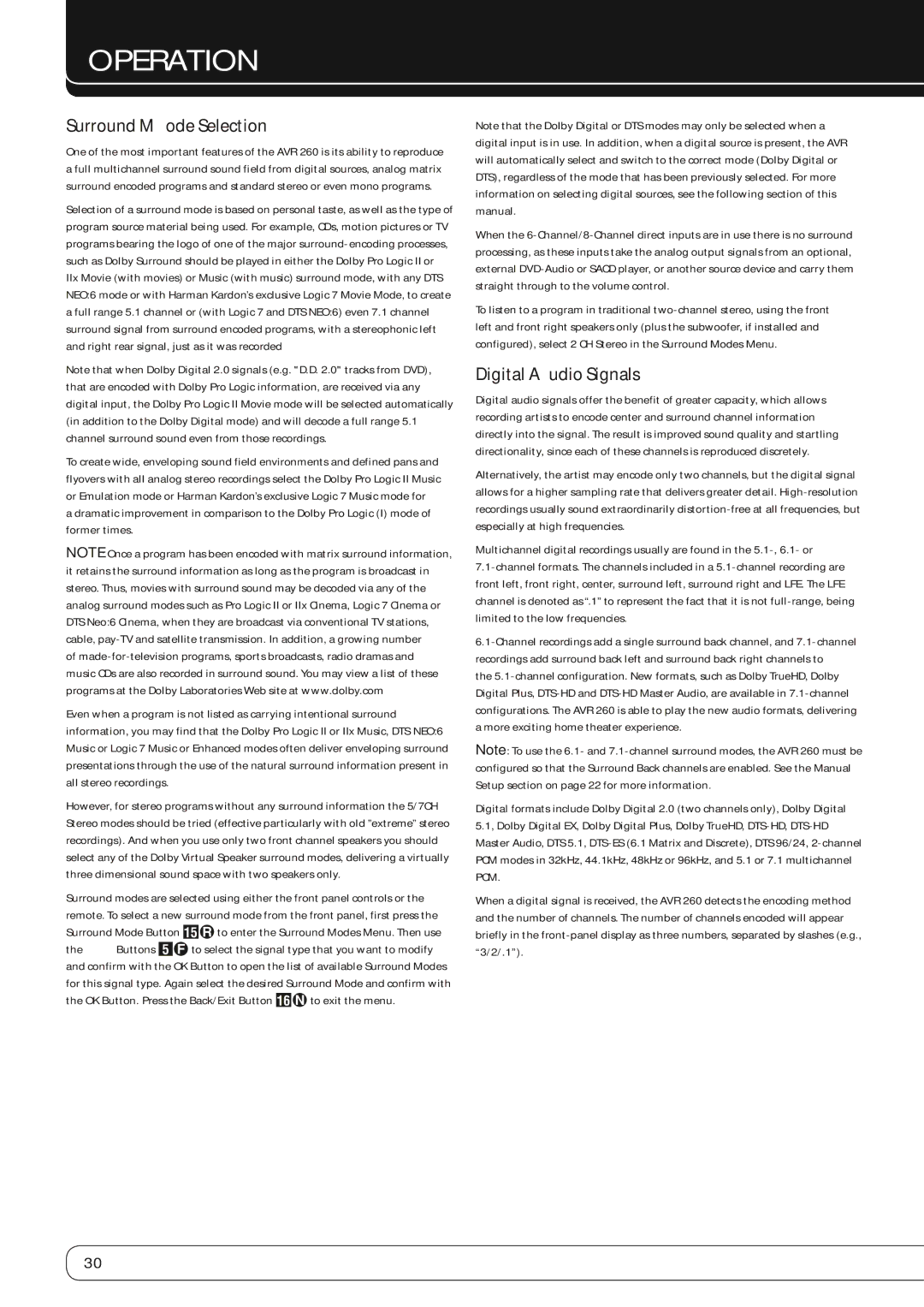
Operation
Surround Mode Selection
One of the most important features of the AVR 260 is its ability to reproduce a full multichannel surround sound field from digital sources, analog matrix
surround encoded programs and standard stereo or even mono programs .
Selection of a surround mode is based on personal taste, as well as the type of
program source material being used. For example, CDs, motion pictures or TV programs bearing the logo of one of the major
Note that when Dolby Digital 2.0 signals (e.g. "D.D. 2.0" tracks from DVD), that are encoded with Dolby Pro Logic information, are received via any digital input, the Dolby Pro Logic II Movie mode will be selected automatically (in addition to the Dolby Digital mode) and will decode a full range 5.1 channel surround sound even from those recordings.
To create wide, enveloping sound field environments and defined pans and flyovers with all analog stereo recordings select the Dolby Pro Logic II Music or Emulation mode or Harman Kardon’s exclusive Logic 7 Music mode for
a dramatic improvement in comparison to the Dolby Pro Logic (I) mode of former times.
NOTE: Once a program has been encoded with matrix surround information, it retains the surround information as long as the program is broadcast in stereo. Thus, movies with surround sound may be decoded via any of the analog surround modes such as Pro Logic II or IIx Cinema, Logic 7 Cinema or DTS Neo:6 Cinema, when they are broadcast via conventional TV stations, cable, pay
of
Even when a program is not listed as carrying intentional surround information, you may find that the Dolby Pro Logic II or IIx Music, DTS NEO:6 Music or Logic 7 Music or Enhanced modes often deliver enveloping surround presentations through the use of the natural surround information present in all stereo recordings.
However, for stereo programs without any surround information the 5/7CH Stereo modes should be tried (effective particularly with old ”extreme” stereo recordings). And when you use only two front channel speakers you should select any of the Dolby Virtual Speaker surround modes, delivering a virtually three dimensional sound space with two speakers only.
Surround modes are selected using either the front panel controls or the remote. To select a new surround mode from the front panel, first press the Surround Mode Button ERto enter the Surround Modes Menu. Then use the KL Buttons 4Fto select the signal type that you want to modify and confirm with the OK Button to open the list of available Surround Modes for this signal type. Again select the desired Surround Mode and confirm with the OK Button. Press the Back/Exit Button FNto exit the menu.
Note that the Dolby Digital or DTS modes may only be selected when a digital input is in use. In addition, when a digital source is present, the AVR will automatically select and switch to the correct mode (Dolby Digital or DTS), regardless of the mode that has been previously selected. For more information on selecting digital sources, see the following section of this manual.
When the
To listen to a program in traditional
Digital Audio Signals
Digital audio signals offer the benefit of greater capacity, which allows recording artists to encode center and surround channel information directly into the signal. The result is improved sound quality and startling directionality, since each of these channels is reproduced discretely.
Alternatively, the artist may encode only two channels, but the digital signal allows for a higher sampling rate that delivers greater detail.
Multichannel digital recordings usually are found in the
the
Note: To use the 6.1- and
Digital formats include Dolby Digital 2.0 (two channels only), Dolby Digital 5.1, Dolby Digital EX, Dolby Digital Plus, Dolby TrueHD,
When a digital signal is received, the AVR 260 detects the encoding method and the number of channels. The number of channels encoded will appear briefly in the
30
